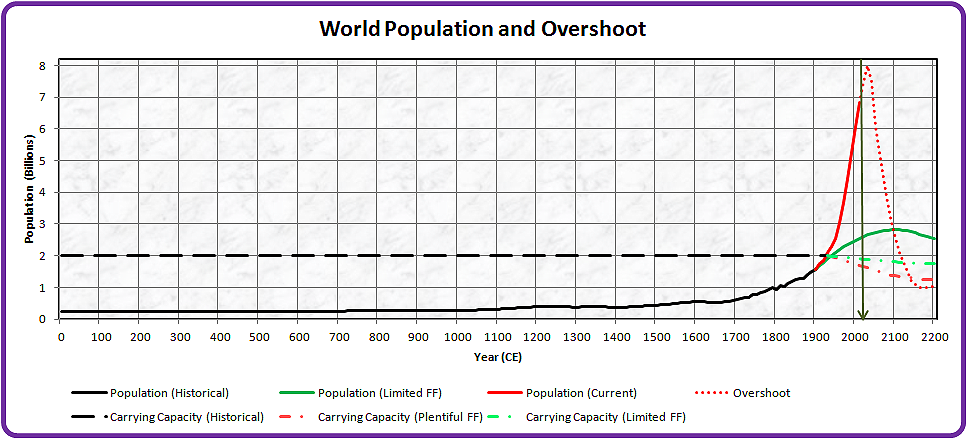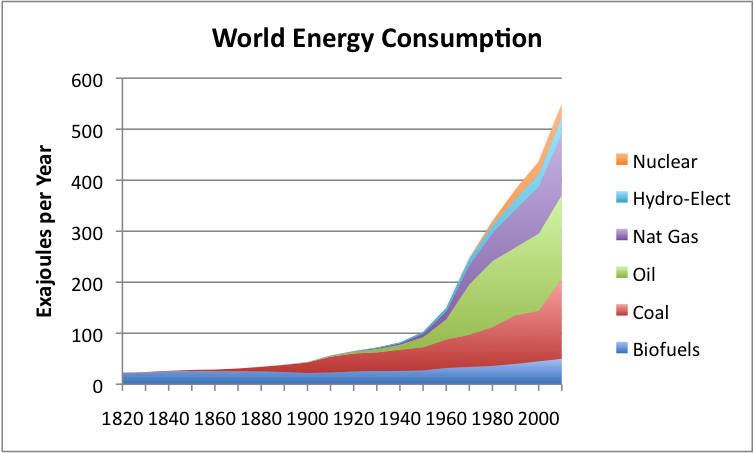| Carrying
Capacity and Overshoot: Another Look |
 In previous articles I've talked at length about the concepts of "carrying capacity" and "overshoot". Because these ideas are fundamental to understanding the predicament in which we humans find ourselves today, I'd like to present my recent thoughts on them. If you have comments, you may email me at paul.chefurka@gmail.com. Or, if you prefer, you may find me on Facebook under the name Bodhi Paul Chefurka, where this article was first published as a pair of notes. Carrying CapacityCarrying capacity is a well-known ecological term that has an obvious and fairly intuitive meaning : "the maximum population size of a species that the environment can sustain indefinitely, given the food, habitat, water and other necessities available in the environment". Unfortunately that definition becomes more nebulous the closer you look at it – especially when we start talking about the planetary carrying capacity for humans. Ecologists claim that our numbers have already surpassed the carrying capacity of the planet, while others (notably economists and politicians...) claim we are nowhere near it yet!I think the confusion arises because we intuitively conflate two very different understandings of the phrase. I call them the “outside” view and the “inside” view. The “outside” view of carrying capacity (I call it CCo) is the view of an observer who adopts a position outside the species in question. It’s the typical analytic/synthetic view of an ecologist looking at the reindeer on St. Matthew’s Island, or at the impact of humanity on other species and its own resource base. CCo is the view that is usually assumed by ecologists when they use the naked phrase “carrying capacity”, and it is an assessment that can only be arrived at through deductive reasoning. From this point of view humanity passed CCo a while ago. It probably happened between 1850 and 1950, depending on what factors you draw into your assessment, but we certainly passeed it before 1975. As you will see below, my estimate for when we passed it is surprisingly early - well before we were aware that it might be a problem. The “inside” view of carrying capacity (I call it CCi) is carrying capacity as seen by a member of the species in question. Rather than arising from an analytical assessment of the overall situation, it is an instinctual, experiential judgement limited strictly to the population of one's own species. All that matters in this view is how many of our own species will be able to survive to reproduce. If that number is still rising, we judge that we have not yet passed CCi. From this point of view humanity has not yet hit CCi, since our population is still growing. It's tempting to ascribe this view mainly to neoclassical economists and politicians, but truthfully most of us tend to see things this way. In fact, all species, including humans, have this orientation whether it is conscious or not. In the case of humans it’s possible to shift our perspective from the CCi view to the CCo view through education, but for most people who are simply living their daily lives, the CCi view dominates their understanding of the human condition. It’s the instinctual view, after all, and is therefore a primary driver of our behaviour - and one that can be only weakly modified by reason. When a species bumps up against CCi their population begins to decline. Humanity is now in the uncomfortable region between CCo and CCi. Outside observers (we Martian ecologists) have detected the overshoot condition, but the population as a whole has not identified it yet. As we approach ever closer to CCi, more and more ordinary people are recognizing the problem as the symptoms become more obvious to casual observers. The problem is, of course, the fact that we've already been in overshoot (above CCo) for quite a while. When we say that humans have “expanded our carrying capacity” through technological innovation, we are using our "inside" voice. From the experiential, subjective, species point of view, we have indeed made it possible for the environment to support ever more people. This is the only view that matters at the biological, evolutionary level. In humans it is this perspective that encourages constant innovation in the face of scarcity. The combination of our immense intellectual capacity for innovation and our biological inability to step outside our chauvinistic, anthropocentric perspective has made it impossible for us to avoid landing ourselves in our current insoluble global ecological predicament. Note: For the academically inclined, the "inside/outside" distinction I develop here is also used by anthropologists who observe other cultures. Anthropologists call them the "Emic" and "Etic" viewpoints. Emic is the native's viewpoint (that I call "inside"), while Etic is the observer's viewpoint (that I call "outside"). OvershootWhen a population surpasses its carrying capacity it enters a condition known as overshoot. Because carrying capacity is defined as the maximum population that an environment can maintain indefinitely, overshoot must by definition be temporary. Populations always decline to (or below) the carrying capacity. How long they stay in overshoot depends on how many stored resources there are to support their inflated numbers. Resources may be food, but they may also be any resource that helps maintain their numbers. For humans one of the primary resources is energy, whether it is tapped as flows (sunlight, wind, biomass) or stocks (coal, oil, gas, uranium etc.). A species usually enters overshoot when it taps a particularly rich but exhaustible stock of a resource. Like oil, for instance...Population growth in the animal kingdom tends to follow a logistic curve: an s-shaped curve that starts off low when the species is first introduced to an ecosystem, then at some later point rises very fast as the population becomes established, then levels out as the population saturates its niche. Humans have been on the front end of our logistic curve for our entire history. Our population has risen very slowly over the last couple of hundred thousand years, as we (very) gradually developed the adaptive skills we needed in order to deal with our varied and changeable environment (language, writing and arithmetic). As we developed and disseminated those skills our ability to modify our environment grew, and so did our growth rate. If we had not discovered the stored energy resource of fossil fuels, we would probably be following the green curve in the chart below, and would be well on our way to achieving balance with the energy flows in the world around us, with our numbers settling down somewhere aroud two billion. This is the road not taken. The road we have taken is the one in red, on which our numbers and consumption have been driven well past the world's long-term carrying capacity, deep into overshoot territory. As we partied hearty since 1900, we have degraded the flow-based carrying capacity of the biosphere by messing up the earth, air and water. As a result, when the party ends, the resulting correction will take us back well below a carrying capacity of two billion, since that no longer exists - we have already "eaten" a big chunk of it while we were in overshoot. The inertia of the correction will carry us even below the remaining carrying capacity, which I estimate might be enough to support about 1.25 billion people.  I don't think we can do anything to prevent the correction. We may have been in overshoot since 1920 or so, based on our usage of fossil fuels shown here:  Graphic by Gail Tverberg: http://ourfiniteworld.com Of course we've learned an awful lot since 1920. If we'd been on the green curve all along we wouldn't have developed wind or solar power, or large-scale hydro. We need to leverage as much of this knowledge as we can - not to prevent the Big Red Spike (we can't, it's already been happening for a hundred years) but to try and slow down the descent a bit, and maybe prevent the Dead Cat Bounce a century from now. Oh, where did I pluck the carrying capacity of 2 billion from? It was the population of the planet in 1925, when we were already using some coal but had just begun to exploit the other two phases of carbon: liquid oil and natural gas. It seems as good a place as any to drive in my picket pin. The details are all speculative, and open to change based on what assumptions you choose to make. The overall shape of the curve, though, will define the human operating environment over the next century or two. In conclusion, I would offer the following thoughts to those who are interested in trying to save civilization. Politics has nothing to offer this situation. The biophysical driver of fossil fuel energy transcends all political boundaries and philosophies. Fossil fuels have supplied 89% of the total primary energy used throughout the world over the last 55 years, and supply 87% of the energy used today, according to BP Statistical Review 2011). Agriculture started the ball rolling about 8,000 years ago, and got our population to 1.8 billion in 1900 without fossil fuels. But the logistical curve didn't take off until the serious use of fossil fuels began in about 1900. Without fossil fuels we'd have seen some additional growth, but nothing like what we've seen in the last 100 years. That's the message of the green line in the above graph. To a first approximation, everything we've done since 1900, including agriculture, has been the result of our use of fossil fuels. That's the message of the red line. We are too close to the inflection point (~20 years or less), and have built too much fossil-dependent infrastructure, for renewables to do more that act as a buffer in some places against the most egregious effects of the decline. As you can see in this graph, the
correlation of primary energy (particularly its primary component of
fossil fuel) and world population is blatantly obvioust. As goes
fossil fuel, so goes humanity.

Paul Chefurka |
| This
article may be reproduced in whole or in part , in any manner and for
any purpose whatsoever, with no restrictions. |